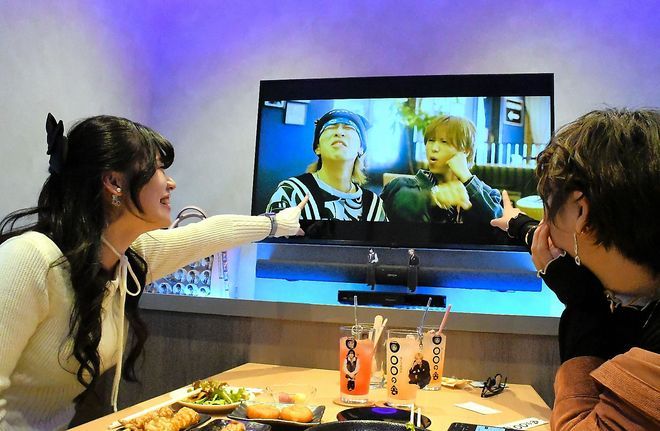Could it be that Gen Z holds the key to Japan’s partial economic recovery?
The Bank of Japan certainly seems to think that might be the case.
It’s because of “oshikatsu,” the term for celebrity-obsessed fans who spend lavishly on merchandise devoted to their idols in the film and entertainment worlds.
For a peek into this peculiar world, Oshikatsu Izakaya Marumaru-no-kai is worth a visit.
The restaurant, built like a karaoke parlor, is located five minutes on foot from Tokyo’s JR Ikebukuro Station.
It was fully occupied one evening in November last year.
The restaurant has 13 private rooms, each with a “noren” curtain at the entrance.
But instead of the sound of singing, raucous cheers erupted from the rooms.
Cries of “Cute!” and “Awesome!” rang out.
A 28-year-old woman from Ibaraki Prefecture was visiting with a friend before attending a concert by boy band Darli’a, their “oshi” (favorite).
They spread out their “treasured” items on the table and watched live concert footage and music videos. They each paid 4,980 yen ($31.70), including tax, for a two-hour all-you-can-eat-and-drink package.
The woman became a fan of the male idol group after attending their concert a year ago. She now goes to their shows up to 10 times a month.
Each time, she buys several photos of her oshi idol at around 1,500 yen a pop.
She also mingles with the group during after-concert meet-and-greets.
The woman spends up to 50,000 yen on tickets and concert merchandise at each gig, sometimes parting with 200,000 yen a month.
She spends the bulk of her income on supporting her favorite idol.
“My purpose in life is to support. That’s why I work hard,” she said.
Members of Generation Z, those in their late teens and 20s, tend to make bulk purchases through their oshikatsu activities, which serves as a driving force to revive consumption.
The Oshikatsu Izakaya restaurant opened in February last year.
It is a new business under the umbrella of Best Printing Co. based in Tokyo’s Minato Ward, which handles booklets used in the medicine industry and other publications.
Women, particularly those in their late 20s and 30s, account for 95 percent of the restaurant’s customers.
“Some customers show up with suitcases filled with goods,” said the manager, Shun Ueda, 34. “I really feel their enthusiasm for oshikatsu.”
An online survey by research company Neo Marketing Inc. covering 22,373 people in March 2024 showed that 1,803 respondents, or 8.1 percent, said they take part in some kind of oshikatsu activity. The rate among men stood at 5.9 percent wile the ratio for women was 13 percent.
Those in their teens and 20s comprised the largest group at 32.7 percent.
The older the respondents were, the lower the percentage was.
So why do so many young people rave about oshikatsu?
Ryo Hirose, a researcher at NLI Research Institute, asserts that it is a way for them to “connect” with society through hobby activities following the collapse of Japan’s lifetime employment system and weakened ties with local communities.
“Their preoccupation with oshi helps them find a meaning unique to themselves,” he said.
Yohei Harada, a professor of marketing for the User Experience Design Course at the Shibaura Institute of Technology in Tokyo, points out that Generation Z actively use social media.
They prefer to have multiple personas, he said, adding, “For them, oshikatsu may be one of the methods to differentiate themselves from others.”
According to research firm Yano Research Institute, the market for idols, anime and 12 other main fields of “otaku” geek culture was worth an estimated total of 800 billion yen in the business year ending in March 2024.
OLDER GENERATIONS
Oshikatsu has become widespread, mainly among members of Generation Z, in recent years.
But middle-aged and older folk also engage in similar activities.
Many of those in their 70s and 80s are enthusiastic about supporting “enka” ballad singer Kiyoshi Hikawa and the vocal group Junretsu.
For example, Masae Miyaji, 48, a corporate worker in Kawasaki, started attending singer Koji Kikkawa’s concerts again in 2019.
She was a fan of him as a senior high school student.
But she felt a renewed nostalgia for his music and was overwhelmed by his performance when she went to his concert for the first time in nearly 25 years.
“I felt I didn’t want to leave any regrets,” she recalled.
BOJ’S ATTENTION
In the meantime, the spending habits on oshikatsu activities have not escaped the attention of the Bank of Japan.
In its quarterly report on regional Japanese economies released last October, the central bank referred to comments by a service industry member in the Tokyo metropolitan area on spending habits among many young people: “Demand for ‘oshikatsu’ is particularly high, and related goods and other merchandise are selling well, resulting in increased average spending per customer. They tend to be eager to spend money at leisure facilities.”
It was the first time for the BOJ to include the word oshikatsu in its quarterly reports, which it started publishing in April 2005.
The latest report, released in January, introduced the view of a business operator in the personal service sector under the jurisdiction of the BOJ’s Nagoya branch: “Although sales prices are rising, goods are selling well on the back of strong demand for oshikatsu activities.”
A BOJ official said it seems to have become commonplace for people to restrain spending on daily expenses so they have more money for “special experiences.”
No matter what generation they belong to, people tend to be budget-minded at times like the present when commodity prices are sky-high.
Still, the central bank is paying attention to the spending patterns of young people, who benefit from wage increases more than older generations.
